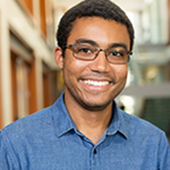Experiencing Human-Centered Design in Action
Auston Ferrarer’s summer work with Johnson & Johnson led to a full-time job with the company, which he'll start after hiking the Appalachian Trail.
A summer spent working around bones might not sound enjoyable for someone with a fear of skeletons.
For Auston Ferrarer, getting past this phobia and excelling during his summer internship with Johnson & Johnson (J&J) provided a pathway to a job he’ll start after graduating from Northwestern's Master of Science in Engineering Design Innovation (EDI) program.
 Ferrarer spent the summer working at DePuy Synthes, a franchise of orthopedic and neurosurgery companies acquired by J&J in 1998. There, he conducted research with surgeons to discover the pain points they face performing a specific kind of wrist surgery. His mission was to provide actionable insights so J&J can design new tools to make those operations less challenging.
Ferrarer spent the summer working at DePuy Synthes, a franchise of orthopedic and neurosurgery companies acquired by J&J in 1998. There, he conducted research with surgeons to discover the pain points they face performing a specific kind of wrist surgery. His mission was to provide actionable insights so J&J can design new tools to make those operations less challenging.
In the process, Ferrarer completed J&J’s competitive internship program to land a highly coveted post-graduation full-time job – and became more comfortable around skeletons along the way.
“It was a good way to address that fear,” Ferrarer said. In a building filled with realistic mockups of bone sections and a basement operating room, "you become desensitized to it after a while.”
That desensitization came quickly for Ferrarer, who observed operations performed on cadavers by surgeons invited in by J&J coordinators. Those demonstrations and additional research gave him a crash course on anatomy — and taught him a valuable lesson.
Ferrarer graduated from the Georgia Institute of Technology in 2020 with a bachelor’s degree in mechanical engineering. He said he was able to use that engineering-heavy foundation and couple it with lessons learned in the EDI program to build a greater understanding of how human-centered design works in the real world.
“One of the biggest things I learned was that design thinking can exist within the context of hardcore engineering,” he said. “People who are in engineering don’t necessarily look at problems through the same lens as designers, but they have similar missions.”
Ferrarer said he learned how to build a bridge between the two camps thanks to the EDI program.
“What I realized is that I can see both sides more clearly,” he said. “I felt like I had much more of a 30,000-foot view of the interaction between those two seemingly different departments, and that will be tremendously helpful going forward.”
Part of that going-forward will be a full-time job with J&J, but he won’t start until January.
Ferrarer plans on hiking the nearly 2,200 miles of the Appalachian Trail from Georgia to Maine after he graduates from EDI in March. Along the way, he wants to chronicle the tales of fellow travelers he encounters — particularly learning the stories behind people's tattoos, a topic he said he's always been interested in.
From there, he'll transition back to J&J. He credited EDI — and its internship requirement — with helping him find his future job.
“Some people come into this program with a lot of corporate experience,” he said. “People like myself come straight out of undergrad. It’s important to have internships as part of this experience because it gives us reassurance that what we're learning here is applicable in industry. My internship showed me it most definitely is.”

